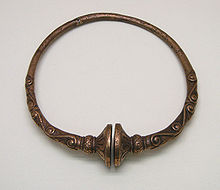
Back Шыйная грыўня Byelorussian Торква Bulgarian Torc'h Breton Torca Catalan Torques Czech Torch Welsh Torque (halssmykke) Danish Torques German Τορκ Greek Torko Esperanto


A torc, also spelled torq or torque, is a large rigid or stiff neck ring in metal, made either as a single piece or from strands twisted together. The great majority are open at the front, although some have hook and ring closures and a few have mortice and tenon locking catches to close them. Many seem designed for near-permanent wear and would have been difficult to remove.
Torcs have been found in Scythian, Illyrian,[1] Thracian, Celtic, and other cultures of the European Iron Age from around the 8th century BC to the 3rd century AD. For Iron Age Celts, the gold torc seems to have been a key object. It identified the wearer, apparently usually female until the 3rd century BC, thereafter male, as a person of high rank, and many of the finest works of ancient Celtic art are torcs. Celtic torcs disappeared in the Migration Period, but during the Viking Age torc-style metal necklaces, mainly in silver, came back into fashion.[2] Similar neck-rings are also part of the jewellery styles of various other cultures and periods.
- ^ The Illyrians by J. J. Wilkes, 1992, ISBN 0-631-19807-5, page 223, "Illyrian chiefs wore heavy bronze torques"
- ^ Jim Cornish, Elementary: Viking Hoards Archived 2007-10-14 at the Wayback Machine, on the Centre for Distance Learning & Innovation Website